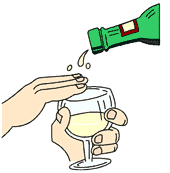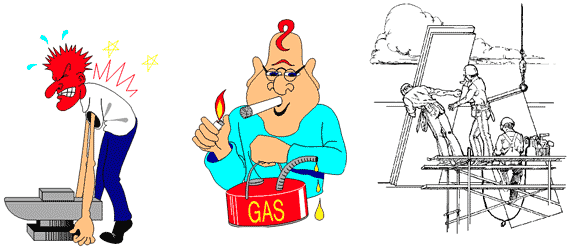Causes Of Accidents
The three contributing factors that result in accidents are as follows.
• Unsafe acts 88%
• Unsafe conditions 10%
• Acts of providence 2%
98 % of all accidents can be prevented due to the causes of these accidents are things people do wrong in the work place.
2 000 000 Accidents were investigated and it was found that for every one major accident that caused death or disablement there can be 10 accidents that only caused minor injuries where only First Aid treatment was required, and 30 accidents that caused property damage.
Basic Causes Of Accidents
Personal Factors
Lack Of Knowledge/Skill, By The Worker.
In short this means that the worker was not trained to do his/her job properly and safely.
Improper Motivation.
The worker is not interested in his/her job.
Physical And Mental Problems.
The worker is not fit to do the job properly or he /she is not capable of doing the job safely. It cannot be expected for a code 14 drivers to perform a brain operation on a patient. The person working in a wood and coal business should be a person who is able to pick up heavy objects and therefore should be a strong person.
Attitudes.
The attitudes of people often relate to the following:
• Home influence
• Education and training
• Job experience
• Personal habits
• Mentally and physically unsuited to do the job
• Work problems and grievances
Job Factors
The following will also contribute to accidents:
• Inadequate work standards (no safe working procedures)
• Inadequate design (equipment that is not properly designed to do the job
• Normal wear and tear (no proper and regular inspection on equipment
• Abnormal usage (substantial equipment that is used, like household equipment used for Industrial purpose)
Main Causes Of Accidents
Some of the main causes of accidents in the workplace that result in injuries, fatalities (Death), or heath hazards are as follows.
• Contact with moving machinery (Hands in the mixer while it is in operation)
• Contact with stationary objects (Good or machinery placed in the working are where workers can bump or trip over resulting in falling or injuring themselves)
• Vehicles (Run over by a car or delivery truck, Forklift, or any vehicle that is used in the workplace)
• Falling objects (Goods stacked on top of places were it can fall of and injure workers)
• Sharp point (Knives, forks and any other sharp objects that can result in cutting or penetrating the body parts of the worker)
• Hard surfaces (Floors, walls machinery that can cause injury by slipping, bumping or falling on)
• Contact with hazardous substances (getting drain cleaner in the eyes or on the skin which is corrosive and can cause blindness, or irritation of the skin)
• Extreme temperatures (Improper ventilation will cause drowsiness and poor performance of the worker and the will lead to injuries)
• Physical exertion (Carrying out tasks, such as lifting or moving objects that are heavy for long periods of time)

Unsafe Acts And Conditions
 An unsafe act is that which is done, or not done by people, causing injury, disease or damage to property, e.g. operating a dangerous machine or equipment while under the influence of alcohol. An unsafe act is that which is done, or not done by people, causing injury, disease or damage to property, e.g. operating a dangerous machine or equipment while under the influence of alcohol.
An unsafe condition, on the other hand normally exists where safety procedures have been neglected, e. g. the safety covers of a machine is removed.
We encounter unsafe conditions and unsafe acts every day in our normal lives, even at home.
Driving through an area where hijackings are common, constitute and unsafe act and an unsafe condition. The unsafe condition is the area where hijackings are common, while the unsafe act is to drive through that area. Avoid these areas if you can.
Lighting a cigarette near explosive materials also constitutes an unsafe act and an unsafe condition – the explosive materials are an unsafe condition and lighting the cigarette is an unsafe act.
A river that is in flood is an unsafe condition, while trying to cross the river while it is in flood is an unsafe act.
A heated stove plate is an unsafe condition, while putting your hand on the heated plate is an unsafe act.
A swimming pool that is not fenced off is an unsafe condition, while leaving a toddler unattended near the swimming pool is an unsafe act.
A swarm of bees in a tree outside the office is an unsafe condition that should be attended to as quickly as possible. There are many people who are allergic to bees, while anyone who is attacked by a swarm of bees runs the risk of being hospitalised or even death.
Here are some examples of unsafe acts and unsafe conditions
Unsafe Acts:
• Failure to warn (not telling the worker of the dangers in the workplace)
• Failure to secure (fail to fasten the top of a ladder while working on a roof)
• Operating at improper speed (working to fast to get the job done, chasing production)
• Making safety devices inoperative (bypassing circuit breakers that keeps on tripping)
• Removing safety devices (removing thermostats from equipment or bypassing earth leakages)
• Using defective equipment (Using electrical equipment where open wiring is visible)
• Failure to use personal protective equipment (PPE) (not using proper cloves when removing hot foods from the oven)
• Improper loading (unsafe loading of goods on a vehicle or trolley which can fall off and injure people)
• Improper placement (storing of foods stuff in the same are were cleaning materials are kept, this can result that the food stuff can be affected and become poi send.
• Improper lifting (picking up heavy objects the wrong way.)
• Improper position for task (taking up a unsafe position while working)
• Horseplay (playing in the work place chasing each other or to through a fellow worker with objects or water)
• Alcohol and drugs (workers working while under the influence of alcohol or drugs can result in injuring them self or fellow workers)

Unsafe Conditions:
• Inadequate guards and barriers (open components of machinery that can have the result that the worker’s hands or clothing can be caught)
• Inadequate PPE (No or little personal protective equipment or the wrong type of PPE)
• Defective tools, equipment or materials (Using a teaspoon to remove chips from the hot oil in a pot. Working at the stove while the extractor unit is out of order)
• Congestion or restricted action (Working in the kitchen where to many workers are. This can result in workers bumping into each other)
• Inadequate warning system (No fire alarm that can be activated if a fire breaks out in the work place)
• Fire and explosion hazard (Flammable liquids stored in areas with extreme temperatures. Storing chemicals in the same area that reacts with each other)
• Bad house keeping (Every thing in its place and a place for every thing. Keep your work place clean, neat and free from obstruction and keep it bacteria free. This is very important in the food preparation process)
• Noise exposure (A area that exceeds a noise level more than 85 disables)
• Temperature extremes (If good ventilation in the workplace are not adequate, this can result in worker are exposed to heat exhaustion, and can become unconscious)
• Inadequate or illumination (Good lighting is very important in the work place to ensure that the worker can do his/her job properly. Where lighting is to extreme workers can also damage there eyes by not using PPE)
• Inadequate ventilation (ventilation in the work place is from utmost importance, lack of proper ventilation can cause workers to become drowsy and this will result in accidents)
|